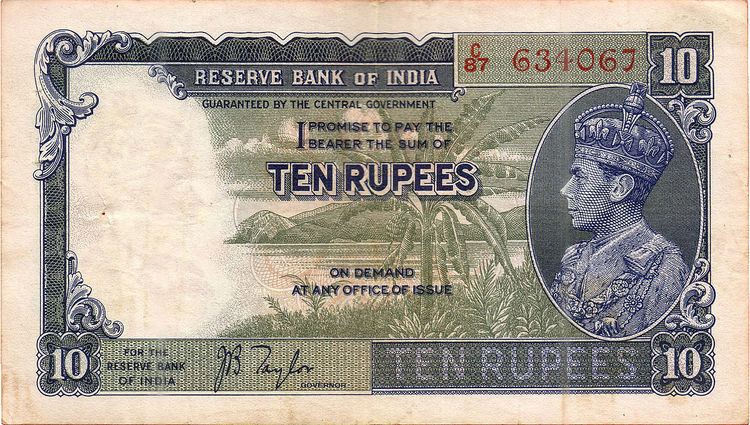Value ₹10 Height 63 mm | Width 137 mm Years of printing June 1996 – present | |
 | ||
Security features Secure thread, latent image, micro-lettering, intaglio print, fluorescent ink, optically variable ink, watermark, and see through register. | ||
The Indian 10-rupee banknote (₹10) is a common denomination of the Indian rupee. The ₹10 note was one of the first notes introduced by the Reserve Bank of India as a part of the Mahatma Gandhi Series in 1996, which is presently in circulation.
Contents
The 10-rupee banknote has been issued and had been in circulation since colonial times, and in continuous production since Reserve Bank of India took over the functions of the controller of currency in India in 1923.
Design
The ₹10 banknote of the Mahatma Gandhi Series is 137 × 63 mm Orange-violet coloured, with the obverse side featuring a portrait of Mahatma Gandhi with a signature of the governor of Reserve Bank of India. It has the Braille feature to assist the visually challenged in identifying the currency. The reverse side features a motif of a Rhinoceros, an elephant and a tiger, all together as Fauna of India.
As of 2011, the new ₹ sign has been incorporated into banknote of ₹10. In January 2014 RBI announced that it would be withdrawing from circulation all banknotes printed prior to 2005 by 31 March 2014. The deadline was later extended to 1 January 2015. Now further dead line was extended to 30 June 2016.
As per an announcement made by the Reserve Bank of India (RBI) in March 2017, a new version of the Indian 10 Rupee note will be issued soon, with better security features. The notes will be printed in the Mahatma Gandhi 2005 series. The new note will have an inset letter ‘L’, on both number panels, along with the governor’s signature. The year of printing will be on the reverse note side. The numerals printed inside both note panels will be in ascending size, from left side to right side.
Security features
The security features of the ₹10 banknote includes:
Languages
As like the other Indian rupee banknotes, the ₹10 banknote has its amount written in 17 languages. On the obverse, the denomination is written in English and Hindi. On the reverse is a language panel which displays the denomination of the note in 15 of the 22 official languages of India. The languages are displayed in alphabetical order. Languages included on the panel are Assamese, Bengali, Gujarati, Kannada, Kashmiri, Konkani, Malayalam, Marathi, Nepali, Odia, Punjabi, Sanskrit, Tamil, Telugu and Urdu.
Lion Capital Series
The 10 rupee banknote of the Lion Capital Series in 1970, had the Ashoka pillar and the banknote denomination written in Hindi, Assamese, Bengali, Gujarati, Kannada, Kashmiri, Malayalam, Marathi, Odia, Punjabi, Sanskrit, Tamil, Telugu and Urdu on the obverse, and featured two peacocks and the banknote denomination written in English on the reverse.
George VI Series
The 10 rupee banknote of the George VI Series in 1937, had the portrait of George VI on the obverse and featured two elephants with the banknote denomination written in Urdu, Hindi, Bengali, Burmese, Telugu, Tamil, Kannada and Gujarati on the reverse.
